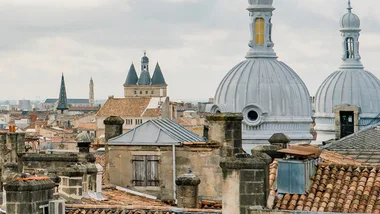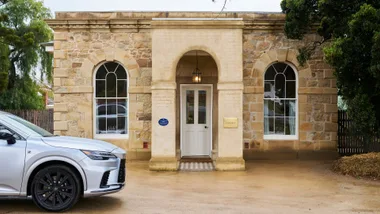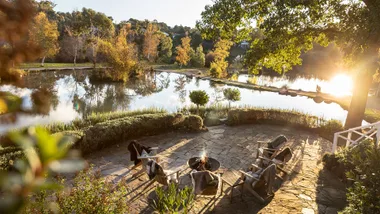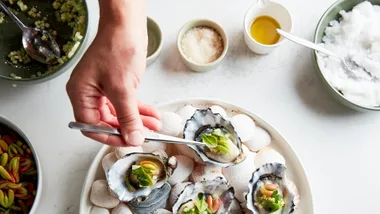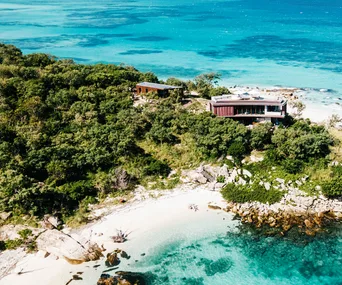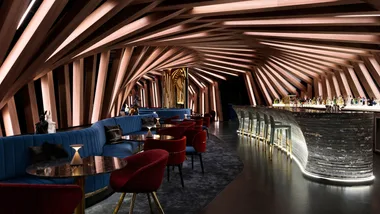The hottest place in Italy that sweltering August night was our train carriage. It was crowded, of course, on Ferragosto, the annual holiday celebrating the Assumption of the Virgin Mary and the start of the Italian summer-holiday season. We were heading south overnight from Rome to Salento, the sun-bleached region in Puglia that forms the stiletto on the Italian boot, and anywhere else in the world the windows would be open on such a night. But not here. A draft on a sweaty neck causes colpo di vento, or a stiff neck, which Italians avoid at all costs, even in August. So by the time Giampiero and I arrived in Salento after nine hours in a sealed carriage, we were thirsty and dishevelled.

Sant’Oronzo, Lecce’s patron saint, overlooks the city
His father picked us up at the station in Lecce, the capital of Salento, in his four-wheel drive and we headed to a café for freshly baked pastries and coffee with almond milk. Risking a colpo di vento, we sat near open windows with a warm, fig-scented breeze wafting in. Giampiero’s father, a psychologist, wore a gold watch and an expensive suit, but he was also an inveterate forager, equally at home in the pasture as the office. In the next week he rarely drove more than a kilometre without pulling over to pluck a dozen figs from a stranger’s field or some prickly pears from a cluster of cacti – how did he do that with bare hands? When we went to the beach he dived for sea urchins, slicing them open with a curved blade to extract the roe. At the lunch or dinner table he’d diligently peel the fruit he’d stolen, distributing plump figs or prickly pears to everyone at the table before heading to the freezer for a bottle of Petrus, a digestivo that concluded every meal.
Giampi’s dad sort of sums up Salento and the Salentini for me: undeniably elegant, but with a wild edge, a reverence for communal meals, and an insatiable appetite for local flavours. This was my impression of Salento on that first holiday 12 years ago with my now former boyfriend, and it’s one that’s confirmed with every visit. I’ve made a habit of returning at least once a year, especially in summer when hot days are cooled by breezes carrying the sweet scent of ripening fruit.
Salento lies at the southernmost tip of the long coastal peninsula of Puglia, at the confluence of the Adriatic and the Ionian seas. Hot and dry, it’s known for its olive groves, forest-clad plateaus and towns embellished with intricately carved stone façades. The region’s proximity to Greece and the Balkans has made it coveted territory since classical antiquity. The Mycenaean Greeks were followed by the Romans, then a long line of invaders: Lombards, Byzantines, Saracens, Normans, Swabians, Angevins, Turks and Venetians. They all left their mark, much of it at the table, and this makes shopping for food and dining in the towns and villages of Salento something of an adventure in time travel. Even now Salento isn’t home to just one culture; the interior, for instance, is inhabited by the Griko, who speak a dialect more closely related to Byzantine Greek than Italian or Salentinu.

Fishing trawlers at Torre San Giovanni
Among the most enduring tastes came from the 9th-century conquest by Saracen Arabs, who brought refined cane sugar and almonds, which were mashed into a paste to produce marzipan, or pasta di mandorla, which is a specialty of many Salentine pastry shops. Eggplant, known to the Greeks and Romans, was reintroduced to Salento by Arabs and a huge range of species flourish to this day, appearing sliced, layered and baked with tomato in a summer dish called parmigiana di melanzane, or simmered with tomato and herbs in marangiane ‘mbuttunate. Most citrus, with the exception of lemons, had vanished from the peninsula after the fall of the Roman Empire, but bitter oranges were most likely returned to southern Italy by the Saracens more than a thousand years ago. Today candied orange peel is sold on its own or encased in dark chocolate.
The Spanish, too, left their mark before being expelled by the most recent conquerors, the Italians, in 1861. They introduced New World produce such as tomatoes, capsicum, zucchini and potatoes, while prickly pears and the custom of transforming cocoa beans into chocolate are part of the sweet Spanish legacy.

Grotta della Poesia, north of Torre dell’Orso in Salento
Most Italians visit the region to bathe at sandy bays and limestone coves; I come for fresh fish caught by men I know by name, pasta made in distinctive regional shapes, and homemade digestivi produced according to century-old family recipes. The openness of Salentini and their devotion to hospitality make these essential features of daily life accessible even to first-time visitors.
We arrive in Lecce by train (mercifully air-conditioned this time) and make a beeline for Piazza Sant’Oronzo, the city’s main square of pietra Leccese, the honey-coloured limestone, wrapped around the partially excavated ruins of a Roman amphitheatre and a monument to the local patron, Saint Orontius. My first snack in Lecce is always a rustico at Alvino, an historic café beloved for its discs of puff pastry stuffed with béchamel, mozzarella, black pepper and a touch of tangy tomato sauce. The café’s display case offers a crash course in Salento’s sweet and savoury snacks – almond-paste biscuits, mostaccioli (biscuits flavoured with cinnamon and cacao), cream-filled bignè and pasticciotti, the classic local breakfast tart filled with thick custard – but we stick to savoury rustici here.
Then we follow the cobbled promenade to another historic café, Cotognata Leccese, near the 16th-century fortress of Castello Carlo V, for its signature cotognata, a quince paste similar to Spain’s membrillo. We buy a couple of thick slices – you never know when you’ll need to return some Salentine hospitality – then pick up a hire car for a 200-kilometre clockwise loop around Italy’s heel. Long-distance train services in the south have been scaled back in the past decade, making a driving holiday the best way to see this part of Puglia.

Aperol Spritz at Caffè Parisi
Leccesi treat their city like an open-air theatre, and their nightly performance of seeing-and-being-seen begins with aperitivo. Before dinner we stop at Quanto Basta, where barmen Diego Melorio and Andrea Carlucci serve craft cocktails from a corner shopfront. With chrome lights illuminating a bar packed with rare imported spirits, Quanto Basta breaks the mould in a city that loves tradition, but the pair champion local flavours in a way that locals embrace. “We make a lot of our syrups with fruits from this region, so many ingredients aren’t so unusual,” Carlucci tells me as he mixes mezcal, Carpano Antica Formula vermouth, Choya umeshu and amarena. His Smoky Taboo symbolises the historical crossroad that Salento occupies: indigenous cherries and Italian vermouth meet Japanese umeshu and New World agave.

A catch at Pescheria del Porto fishmongers
The view next morning on the eastern outskirts of Lecce is sobering. For two consecutive harvests Salento’s centuries-old olive trees have been ravaged by a deadly bacterium, Xylella fastidiosa, which leaves the trees barren and looking as though they’ve been burned by fire. There’s no known cure, and it’s spreading. We head east through dying olive groves to the coastal road, timing breakfast with our arrival at an old-school pastry shop called Nobile in the humble seaside town of San Cataldo. Half of my Salentino friends name Nobile as their favourite place for pasticciotti, served on gold-foil platters at plastic tables (the other half nominate Pasticceria Ascalone in Galatina). We take our pasticciotti with Salento’s summer drink of choice: caffè in ghiaccio, chilled espresso flavoured with latte di mandorla, a sweet almond extract. From here we drive south, past the rugged coves of San Foca, Torre dell’Orso, and Sant’Andrea. The currents have chiselled the limestone cliffs of these villages into a moonscape of crescent-shaped grottoes. In more adventurous times I’d park on the side of the road north of Torre dell’Orso, deposit my towel on the rough limestone platform overlooking the sea and join a queue of local daredevils to dive 15 metres into the turquoise waters of Grotta della Poesia. These days I stick to a rock-hewn staircase descending to the beach near Tricase.
After a dip in the Adriatic, we cut across the peninsula to Salento’s Ionian coast, where seaside towns bear names of the torri, the defensive towers that protected their inhabitants for centuries. At Torre San Giovanni, a fishing village and popular summer-home enclave for landlocked Salentines, we meet Enzo Bruno on his trawler. He leads the Padre Pio fishing cooperative, named for a recently canonised Franciscan saint, and he and a dozen or so fellow fishermen are dedicated to sustainable practices in the hope of fixing the damage caused by long-term overfishing. “We have special nets,” he says, gesturing at the one hauled onto the deck, dotted with wriggling fish caught at dawn in the Secche di Ugento, a once-decimated shallow nature reserve. “They’re designed to catch fish only once they are a certain length so we know they have reached reproductive age.” Today he has caught mullets, Atlantic stargazers and sea bream, as well as a few cuttlefish, which he sells at a shop near his moored boat. “It has taken time to educate people that the sea won’t always give us fish if we demand too much, so we have to limit what we catch. But slowly, we are helping people understand. If we want to keep doing this job, this is the only way.”

Caffè in ghiaccio, caffè macchiato and pasticciotti
Next stop is the sprawling town of Gallipoli. In an otherwise nondescript apartment block in the new quarter is the modest headquarters of a family business that produces a true taste of the south. In 2001 Angela Margapoti and her parents, Fernando and Antonietta, founded Amaro Margapoti, an artisanal liquor company producing an amaro and other herbal digestivi according to family recipes using Salentine herbs. Fernando and Antonietta, retired teachers, had made amaro for themselves for decades. “Since we had the summers off and loved to travel, we would pack up our roulotte [caravan] and drive off to some part of Italy with provisions, including our bottles of amaro,” Antonietta says, sitting in the kitchen where the family macerates cinchona bark, cloves, cinnamon, bay leaves and other natural flavourings with spirit. “When the bottles were empty, we knew it was time to come back.”
Most of Amaro Margapoti’s customers are in the north, in Rome and Milan, but Angela takes us to meet one of her local clients, chef Andrea Capoti, of Capitoni Coraggiosi, a harbourside restaurant in the old quarter. Our lunch of local seafood – raw red prawns, marinated cuttlefish and roasted octopus – is paired with a rosato made from an indigenous grape called negroamaro, a common coupling with fish in Salento, and finished, of course, with Amaro Margapoti’s sweet and sour citrus flavours with a pleasantly bitter finish.

Prawns, cuttlefish and crudo at Capitoni Coraggiosi in Gallipoli
About half an hour’s drive east of Gallipoli, fourth-generation winemakers Paolo and Gabriele Nutricato grow negroamaro, malvasia nera di Lecce, primitivo and a few little-known white varieties for their winery, Cantina Supersanum. Greeks introduced grapes to the peninsula during the Iron Age and the vines have flourished ever since; the region’s high-alcohol reds have been used in blends since the 19th century to impart colour and structure. Cantina Supersanum is among a growing group of small producers focused on low-yield organic and minimal-intervention winemaking.
The brothers climb aboard and together we drive from their cantina – a converted garage in the village of Supersano – to their vineyards. Standing among the vines, Paolo gestures across the road to a desolate olive grove afflicted with Xylella fastidiosa. “In the post-war era, subsidies were offered to farmers to pull out their vines to plant olive trees, so you had this whole trend towards monoculture,” he says, adding sadly, “Nature rebelled.” With their dark ruby colour, Supersanum’s rosato wines would pass for reds elsewhere, but they have pleasant acidity that renders them light and drinkable, perfectly suited to Salento’s fish and vegetable dishes. I buy a few bottles at the cantina to share with my friends at L’Orecchietta, a shop and trattoria in Guagnano, about an hour’s drive north.

Orecchiette being made at L’Orecchietta in Gallipoli
L’Orecchietta is named for the region’s signature durum-wheat pasta, ear-shaped orecchiette made from scraps of dough dragged across a wooden surface with a knife. Lisetta Scarciglia started selling fresh pasta to busy cooks at her shop in Guagnano in 1991 and soon the business grew to include a full menu of dishes to take away or enjoy at an adjacent trattoria. Now her whole family works here. “Everyone in Guagnano used to make pasta at home – vendors would go around town selling iron tools for special shapes – but things have changed,” Lisetta tells me as she rolls sagne ‘ncannulate, twisted pasta ribbons.
L’Orecchietta is packed by early evening. Lisetta is busy in the shop, but her children, Simona and Mino, join us at our patio table beneath a magnolia tree for one of the region’s signature dish, pezzetti di cavallo, cubes of lean horsemeat simmered in tomato sauce. Around us appear slices of airy focaccia studded with cherry tomatoes, and plates of orecchiette dressed in passata and dusted with ricotta salata. The wine list is impressive for such a casual venue, but our BYO Supersanum “Sinergico” rosato is the first our hosts have tasted. Wait, I urge, and race down to the car to fetch the cotognata. With the quince jelly, a wedge of pecorino and glasses of negroamaro, we toast old friendship and southern hospitality.
GETTING THERE
Lecce is about half an hour’s drive south of Brindisi Airport, which is served by regular flights from Milan, Rome, Bologna, Barcelona, London and Paris. Direct trains from Rome to Lecce take about five and half hours.
WHERE TO STAY
Casa dei Mercanti The nine self-catering suites in a Fascist-era building on Lecce’s largest square are ideal for those who want to make the most of Salento’s produce markets. Piazza Sant’Oronzo 44, Lecce, +39 0832 279819, casadeimercantisuites.i
Don Totu Near the coastal towns of Castro and Santa Cesarea Terme, this six-room B&B features gardens, a pool, gym, library and Turkish bath. Via Crocefisso 10, San Cassiano, +39 0836 992374, dontotu.it
La Fiermontina This “urban resort” of 16 rooms occupies a refurbished 17th-century villa at the edge of Lecce’s historic centre. Piazzetta de Summa Scipione 4, Lecce, +39 0832 302481, lafiermontina.com
Masseria Trapanà On the outskirts of Lecce, this rural retreat occupies a former fortified farmhouse. Strada Provinciale 236, Surbo-Casalabate, +39 0832 1832101, trapana.com
WHERE TO EAT
Farmacia dei Sani The innovative dishes at this restaurant deep in Salento’s interior are inspired by regional flavours and elevated using modern techniques. Piazza del Popolo 14, Ruffano, +39 339 833 2514
La Succursale This busy pizzeria serves thick-rimmed pizze with craft beer, as well as salads, legume dishes and cheese plates. Viale dell’Università 15, Lecce, +39 391 497 7749
Le Macàre This trattoria serves Salentino specialities such as eggplant stuffed with mozzarella and ragù misto, pork and beef simmered overnight in puréed tomatoes. Via Mariana Albina 140, Alezio, +39 0833 282192, lemacare.it
L’Orecchietta This pasta shop and trattoria in Guagnano sells fresh pasta made in local shapes and traditional dishes to take away or dine in. Via Vittorio Veneto 49, Guagnano, +39 334 722 0264, lorecchietta.com
Lu Pescatore This family-run trattoria specialises in fish caught in the nearby nature reserve. Corso Annibale 1, Torre San Giovanni di Ugento, +39 0833 937018
Rua de Li Travaj Expect earthy regional specialties such as pittule (fried dough fritters) and ceci e tria (chickpeas with boiled and fried pasta). Via Felice Cavallotti 44, Patù, +39 349 058 4531
WHERE TO DRINK
Quanto Basta This craft cocktail bar is Salento’s first foray into the world of global spirits, combining foreign and domestic flavours. Via Marco Basseo 29, Lecce, +39 347 008 3176
Cubi A new craft cocktail bar from the team behind Quanto Basta, mixing classic cocktails in southern Salento. Via S. Giuseppe 12, Maglie
Alvino Its location in Lecce’s busiest square makes this café a point of reference for locals, for pastries, coffee and aperitivi. Piazza Sant’Oronzo 30, Lecce, +39 0832 246748, catamo.it
Bar Cotognata Leccese Renowned for sweet specialties and cotognata, Lecce’s quince paste. Viale Marconi 51 Lecce, +39 0832 302800, cotognataleccese.com
Pasticceria Ascalone Founded in 1740, this institution in its 10th generation of family ownership attracts pasticciotti lovers from across Salento. Via Vittorio Emanuele 17, Galatina, +39 0836 56600
Pasticceria Nobile Pasticciotti are served hot out of the oven at this café near the sea in San Cataldo. Via Marco Polo 9, San Cataldo, +39 0832 65059
Caffè Parisi Come for its large aperitivo snack spread and stay for its prime position in Nardò’s elegant historic centre. Piazza Antonio Salandra 38, Nardò, +39 0833 182 3223

